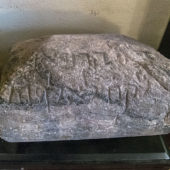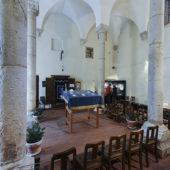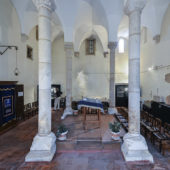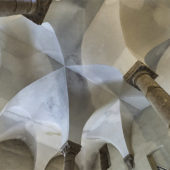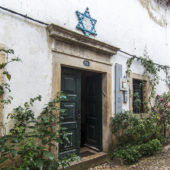The oldest well-preserved synagogue in Portugal
By Luis Vasco:
The Synagogue ofTomar is currently the oldest well-preserved Hebrew Temple (house ofworship) in Portugal.
Although there was already a Jewish community in Tomar, from at least the early years of the l4th century (as is proven by the inscription on the gravestone of Rabbi Joseph ofTomar, who died in Faro in 1315), it only acquired real importance in the 15th century, when its Synagogue was constructed between 1430 and 1460. The Synagogue was used as a Jewish house of worship and meeting place only a few years. In December of 1496 the King D. Manuel, at the insistence of his bride the Castillian princess D. lsabel, issued an edict that gave Jews until October of 1497 to either convert to Christianity or leave Portugal. Some agreed to accept baptism; others were forced to and came to be called New Christians. But many,despite having been baptized, continued secretly to practice Judaism. These latter were dubbed The Marranos.
After the edict of 1496, the Jewish community of Tomar vacated the Synagogue which, once all signs ofJewish worship were removed, was bought by a private individual who about 1516 sold it with the express purpose that there be installed therein the prison that until then was in the village castle.
lt is noteworthy that the New Christians of Tomar, through the charter of exceptional privileges granted by D. Manuel in 1516, could not be imprisoned. This perhaps may be explained by the fact that the public prison was located in the former Synagogue, detainment in which would represent, for the former Jews, the ultimate affront.
How long was the prison installed on that building? … Probably until its definitive settlement in the town hall between 1542 and 1550.
We find an early 17th century document that shows the new use to which the old Synagogue was put after having served as a prison . It is a curious entry found in the oldest book ofthe parish records of St. John the Baptist Church, through which we know that there existed on New Street a St. Bartholomew’s Chapel in which a wedding was conducted in 1613. It has nol yet been possible to determine the date of its desecration, but according to Joao dos Santos Simoes, we believe this occurred in the 19th century.
On June 1, 1885, the Synagogue was a single storeyed house serving as a hayloft, belonging to Jose Joaquim de Araujo who sold it to Antonio Vieir a da Silva Neves. At his death the building became the property of his son-in-law, Joaquim Cardoso Tavares .
On June lO, 1920, at the time of a research visit by Colonel Garcez Teixeira and a small group of Portuguese archaeologists, the little landmark was a common cellar and grocery warehouse. By the decree of July 29, 1921 the building was classified a National Monument.
About two years later, on May 5, 1923, the eminent Hebraist Engineer Samuel Schwarz contracted for the purchase of the building from its owner Joaquim Cardoso Tavares, with the purpose of preserving it from complete abandonment and defacement. He ordered that there be undertaken, at his personaJ expense, the first round of cleaning and excavation.
Beginning in 1933 the local Tourism Commission sought to acquire, through purchase by the State, the transfer of the Synagogue building, that there might be installed therein an Luso-Hebraic museum. The transaction was not consummated for the lack of the necessary funds, but the issue was resolved when the owner of the old Synagogue building donated it to the Portuguese State on the express condition that there be installed therein a Luso-Hebraic museum.
The official creation of the Museum was ratified by the Ministerial communique of July 27, 1939. Thereupon, a study was begun into the possibility of installing not only a museum of gravestones and inscriptions but also a history museum depicting the cultural activities of the ancient Portuguese Jews worthy of the recognition of the Nation.
Now, with the precious help from many friends all over the world, we are trying to establish a museum and library of the History of the Jews in all the Nations of the world.


